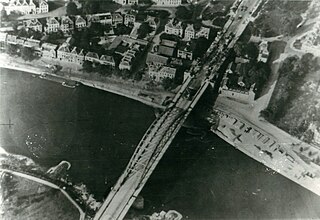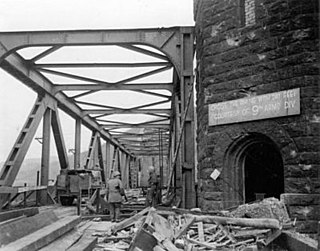
The Meuse or Maas is a major European river, rising in France and flowing through Belgium and the Netherlands before draining into the North Sea from the Rhine–Meuse–Scheldt delta. It has a total length of 925 km.

Operation Market Garden was an Allied military operation during the Second World War fought in the Netherlands from 17 to 27 September 1944. Its objective was to create a 64 mi (103 km) salient into German territory with a bridgehead over the River Rhine, creating an Allied invasion route into northern Germany. This was to be achieved by two sub-operations: seizing nine bridges with combined U.S. and British airborne forces (Market) followed by land forces swiftly following over the bridges (Garden).

The Battle of Arnhem was a battle of the Second World War at the vanguard of the Allied Operation Market Garden. It was fought in and around the Dutch city of Arnhem, the town of Oosterbeek, the villages Wolfheze and Driel and the vicinity from 17 to 26 September 1944. The Allies were poised to enter the Netherlands after sweeping through France and Belgium in the summer of 1944, after the Battle of Normandy. Operation Market Garden was proposed by Field Marshal Sir Bernard Montgomery, who favoured a single push northwards over the branches of the Lower Rhine River, allowing the British Second Army to bypass the Siegfried Line and attack the Ruhr. US Airborne troops were dropped in the Netherlands to secure bridges and towns along the line of the Allied advance. Farthest north, the British 1st Airborne Division landed at Arnhem to capture bridges across the Nederrijn, supported by men of the Glider Pilot Regiment and the 1st Polish Parachute Brigade. The British XXX Corps were expected to reach the British airborne forces in two to three days.

Grave is a city and former municipality in the Dutch province of North Brabant. The former municipality had a population of 12,486 in 2021. Grave is a member of the Dutch Association of Fortified Cities.

Operation Tonga was the codename given to the airborne operation undertaken by the British 6th Airborne Division between 5 June and 7 June 1944 as a part of Operation Overlord and the D-Day landings during World War II.

Michael Allmand VC was an English Second World War recipient of the Victoria Cross, the highest and most prestigious award for gallantry in the face of the enemy that can be awarded to British and Commonwealth forces.

Captain John Hollington Grayburn VC was an English recipient of the Victoria Cross, the highest and most prestigious award for gallantry in the face of the enemy that can be awarded to British and Commonwealth forces.

The German invasion of the Netherlands, otherwise known as the Battle of the Netherlands, was a military campaign part of Case Yellow, the Nazi German invasion of the Low Countries and France during World War II. The battle lasted from 10 May 1940 until the surrender of the main Dutch forces on 14 May. Dutch troops in the province of Zeeland continued to resist the Wehrmacht until 17 May when Germany completed its occupation of the whole country.

The 5th Parachute Brigade was an airborne forces formation of brigade strength, raised by the British Army during the Second World War. Created during 1943, the brigade was assigned to the 6th Airborne Division, serving alongside the 3rd Parachute Brigade and the 6th Airlanding Brigade.

The Battle of Remagen was an 18-day battle during the Allied invasion of Germany in World War II from 7 to 25 March 1945 when American forces unexpectedly captured the Ludendorff Bridge over the Rhine intact. They were able to hold it against German opposition and build additional temporary crossings. The presence of a bridgehead across the Rhine advanced by three weeks the Western Allies' planned crossing of the Rhine into the German interior.

The Battle of Fort Eben-Emael was a battle between Belgian and German forces that took place between 10 May and 11 May 1940, and was part of the Battle of Belgium and Fall Gelb, the German invasion of the Low Countries and France. An assault force of German paratroopers, Fallschirmjäger, was tasked with assaulting and capturing Fort Eben-Emael, a Belgian fortress whose strategic position and strong artillery emplacements dominated several important bridges over the Albert Canal. These carried roads which led into the Belgian heartland and were what the German forces intended to use to advance. As some of the German airborne forces assaulted the fortress and disabled the garrison and the artillery pieces inside it, others simultaneously captured three bridges over the Canal. Having disabled the fortress, the airborne troops were then ordered to protect the bridges against Belgian counter-attacks until they linked up with ground forces from the German 18th Army.

The Battle of Rotterdam was a Second World War battle fought during the Battle of the Netherlands. Fought between 10 and 14 May 1940, it was a German attempt to seize the Dutch city. It ended in a German victory, following the Rotterdam Blitz.

Major Robert Henry Cain VC TD was a Manx recipient of the Victoria Cross, the highest award for gallantry in the face of the enemy that can be awarded to British and Commonwealth forces.
Colonel John Llewellyn Waddy OBE was a British Army officer who served during the Second World War, Palestine and the Malayan Emergency before becoming Colonel of the SAS.

John Samuel "Jocko" Thompson was a professional baseball pitcher. He played all or part of four seasons for the Philadelphia Phillies of Major League Baseball from 1948 to 1951. He also served in the Army of the United States as a first lieutenant in the European theater during World War II. Thompson played in Major League Baseball during the Whiz Kids era during a career which spanned 12 seasons. After attending Northeastern University, Thompson appeared as a situational pitcher and spot starter during the 1948, 1949, and 1950 seasons with the Phillies, and went 4–8 in his only season as a regular member of the team's starting rotation. After demotion to the minors in 1952, Thompson retired from baseball after the 1955 season.

The capture of the Caen canal and Orne river bridges was an operation by airborne forces of the British Army that took place in the early hours of 6 June 1944 as part of the Normandy landings of the Second World War. The objective was to capture intact two road bridges in Normandy across the River Orne and the Caen canal, providing the only exit eastwards for British forces from their landing on Sword Beach. Intelligence reports said both bridges were heavily defended by the Germans and wired for demolition. Once captured, the bridges had to be held against any counter-attack, until the assault force was relieved by commandos and other infantry advancing from the landing beach.

The Maas–Waal Canal is a canal in the Netherlands that connects the river Meuse to the river Waal. The channel is about 13.5 kilometres (8.4 mi) long and runs from Weurt to the south and ends at Heumen. The connection of the Meuse and the Maas–Waal Canal is the tripoint between the provinces of Gelderland, Limburg and North Brabant.

The Zoo flak tower was a fortified flak tower that existed in Berlin from 1941 to 1947. It was one of several flak towers that protected Berlin from Allied bomber raids. Its primary role was as a gun platform to protect the government building district of Berlin; in addition, the Hochbunker (blockhouse) was designed to be used as a civilian air-raid shelter. It also contained a hospital and a radio transmitter for use by the German leadership, and provided secure storage facilities for art treasures.

The Battle of Nijmegen, also known as the Liberation of Nijmegen, occurred from 17 to 20 September 1944, as part of Operation Market Garden during World War II.

Operation Pheasant, also known as the Liberation of North Brabant, was a major operation to clear German troops from the province of North Brabant in the Netherlands during the fighting on the Western Front in the Second World War. This offensive was conceived as a result of the failure of Operation Market Garden and the allied effort to capture the important port of Antwerp. It was conducted by the allied 21st Army Group between 20 October to 4 November 1944.


























